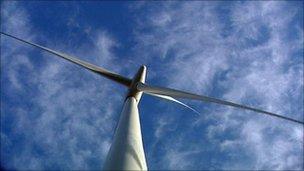Scotland's offshore windfarm plans knocked back
- Published

The plans for some of the windfarms faced local opposition
Three proposed windfarms close to the shores of Kintyre, in the Solway Firth and Wigtown Bay have been knocked back by the Scottish government.
The marine energy plans have faced local opposition during a consultation.
The proposals covered 10 possible windfarms, six of which won approval. Developers dropped plans for another.
An found that the tourism sector would face the biggest losses because of the turbines' visual impact.
The Scottish government has control on planning issues within 12 miles (19.3km) of the shore and the UK government handles planning beyond that.
It has already approved large windfarms, including the Forth and Moray firths.
Local losses
Across the 10 sites being considered in the first wave of the inshore windfarms, it was reckoned that tourism could lose as much as 拢3.5m per year. Most of that would be in Argyll and the south of Scotland.
Fisheries could have lost up to 拢1.65m annually had all the plans been developed.
It was estimated that the total cost to local economies, including businesses such as leisure boating, could come to more than 拢8m.
Estimates of the overall cost to local economies over 50 years varied from 拢1m to 拢169m.
While ministers served notice that developers should not pursue plans for the south west sites, they have given the green light to six other sites. These can now move ahead for individual planning permission.
Three of the approved sites are off the Firth of Forth and the Firth of Tay.
One is east of Caithness, with further zones west of Islay and Tiree. A tenth site, near the Bell Rock lighthouse, was withdrawn by developers before ministers reached their decision.
These ten proposed sites - chosen by windfarm developers - were counted as short-term plans, while very large offshore windfarms are part of a separate planning process overseen by the UK government and the Crown Estate.
Projects opposed
In the next medium-term phase for inshore windfarms within 12 miles (19.3km) of the Scottish coast, areas being considered include large sea areas north of Lewis and Sutherland, south of Barra and west of Colonsay.
Local opposition to the Kintyre and south west sites was voiced during last year's consultation, to which there were 856 responses.
Scottish Environment and Rural Affairs Secretary Richard Lochhead claimed the projects approved could power three million homes by 2020.
"Realising and harnessing this potential must be done in a sustainable way that ensures communities can also benefit from the new economic opportunities presented by this growing industry," he said.
"That is exactly what today's publication is about - understanding the effects that offshore renewable developments might have on the surrounding area."
The decision to prevent development of a wind farm at Wigtown Bay, off Dumfries and Galloway, was welcomed by campaigners.
Roy Walter, of campaign group Keep Wigtown Bay Natural, said its hard work had finally paid off.
"Obviously it is what we have worked for the past six months," he said.
"To use a clich茅, it is a victory for common sense.
"As we have said all along it should never have made the draft plan anyway, so the outcome from our point of view is met with some satisfaction."